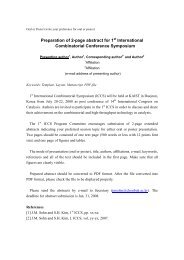Bidding - the International Association of the Catalysis Societies
Bidding - the International Association of the Catalysis Societies
Bidding - the International Association of the Catalysis Societies
Create successful ePaper yourself
Turn your PDF publications into a flip-book with our unique Google optimized e-Paper software.
C&EN Volume 78, Number 21, p. 8-9 (May 22, 2000)<br />
Epoxidation Catalyst Immobilized In Ionic Liquid<br />
Chemists in South Korea have employed a room-temperature ionic liquid to immobilize, recover, and<br />
recycle a homogeneous chiral catalyst that is used for <strong>the</strong> asymmetric epoxidation <strong>of</strong> alkenes.<br />
Principal research scientist Choong Eui Song and research scientist Eun Joo Roh at <strong>the</strong> Korea Institute <strong>of</strong><br />
Science & Technology, Seoul, immobilized a catalyst known as Jacobsen's chiral (salen)- manganese(III)<br />
epoxidation catalyst in <strong>the</strong> air- and moisture-stable ionic liquid 1-butyl-3-methylimidazolium<br />
hexafluorophosphate, [bmim][PF 6 ]. They showed that <strong>the</strong> immobilized catalyst can be recycled five times<br />
when used for <strong>the</strong> asymmetric epoxidation <strong>of</strong> 2,2-dimethylchromene and o<strong>the</strong>r alkenes with only a slight<br />
decrease in enantioselectivity and activity [Chem. Commun., 2000, 837].<br />
"Song and Roh describe remarkable results in a very exciting new field--oxidation chemistry in ionic<br />
liquids," notes Peter Wasserscheid, chemistry lecturer at <strong>the</strong> University <strong>of</strong> Technology, Aachen, in<br />
Germany, whose own research includes catalytic reactions in ionic liquids. "Their work gives a clear hint<br />
that selective oxidation may be ano<strong>the</strong>r area where <strong>the</strong> unique solvent properties <strong>of</strong> ionic liquids can<br />
make a difference."<br />
Immobilized chiral catalysts <strong>of</strong>fer practical advantages over soluble catalysts by facilitating separation <strong>of</strong><br />
<strong>the</strong> catalyst from reagents and products after <strong>the</strong> reaction and by simplifying catalyst recycling, Song and<br />
Roh point out. However, most immobilization techniques, such as anchoring a catalyst to a solid support,<br />
usually require structural modification <strong>of</strong> <strong>the</strong> catalyst and can lead to partial loss <strong>of</strong> activity or<br />
enantioselectivity or both.<br />
"Although several attempts to immobilize Jacobsen's (salen)Mn(III) epoxidation catalyst have been made,<br />
no successful procedure has been reported until now," Song tells C&EN. "We have shown that Jacobsen's<br />
catalyst in a reaction medium containing [bmim][PF 6 ] exhibits comparable enantioselectivities in<br />
asymmetric epoxidation <strong>of</strong> alkenes to those obtained without an ionic liquid.<br />
"One <strong>of</strong> <strong>the</strong> major novelties <strong>of</strong> this immobilization technology using ionic liquids is that <strong>the</strong><br />
homogeneous chiral catalyst can be used without any structural modification," he continues. "Moreover,<br />
we observed remarkable rate enhancement for <strong>the</strong> asymmetric epoxidation <strong>of</strong> 2,2-dimethylchromene in<br />
<strong>the</strong> presence <strong>of</strong> [bmim][PF 6 ]."<br />
Song and Roh showed that epoxidation <strong>of</strong> <strong>the</strong> alkene was complete in two hours, whereas <strong>the</strong> same<br />
reaction without an ionic liquid required six hours.<br />
- 75 -



